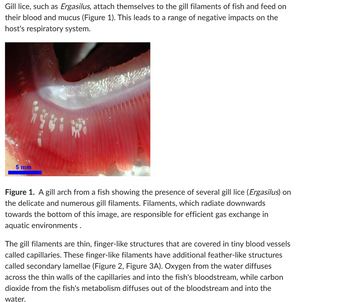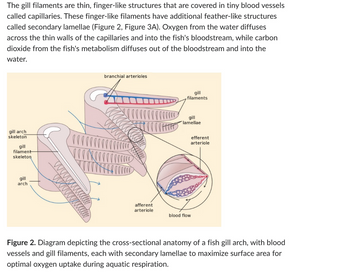
Human Anatomy & Physiology (11th Edition)
11th Edition
ISBN: 9780134580999
Author: Elaine N. Marieb, Katja N. Hoehn
Publisher: PEARSON
expand_more
expand_more
format_list_bulleted
Question
a)
Gill lice infections result in lowered surface area to volume ratios in fish gill structure.
| True | |
| False |
Levels of carbon dioxide in the blood will not differ between infected and uninfected fish.
Question options:
| True | |
| False |
The branched nature of capillaries in fish gills increases surface area, and thus the efficiency of exchange into/out of the blood stream lation.
Question opti
| True | |
| False |

Transcribed Image Text:Gill lice, such as Ergasilus, attach themselves to the gill filaments of fish and feed on
their blood and mucus (Figure 1). This leads to a range of negative impacts on the
host's respiratory system.
5 mm
R
Figure 1. A gill arch from a fish showing the presence of several gill lice (Ergasilus) on
the delicate and numerous gill filaments. Filaments, which radiate downwards
towards the bottom of this image, are responsible for efficient gas exchange in
aquatic environments.
The gill filaments are thin, finger-like structures that are covered in tiny blood vessels
called capillaries. These finger-like filaments have additional feather-like structures
called secondary lamellae (Figure 2, Figure 3A). Oxygen from the water diffuses
across the thin walls of the capillaries and into the fish's bloodstream, while carbon
dioxide from the fish's metabolism diffuses out of the bloodstream and into the
water.

Transcribed Image Text:The gill filaments are thin, finger-like structures that are covered in tiny blood vessels
called capillaries. These finger-like filaments have additional feather-like structures
called secondary lamellae (Figure 2, Figure 3A). Oxygen from the water diffuses
across the thin walls of the capillaries and into the fish's bloodstream, while carbon
dioxide from the fish's metabolism diffuses out of the bloodstream and into the
water.
gill arch
skeleton
gill
filament
skeleton
gill
arch
sss
branchial arterioles
peper
with
afferent
arteriole
gill
filaments
gill
lamellae
blood flow
efferent
arteriole
Figure 2. Diagram depicting the cross-sectional anatomy of a fish gill arch, with blood
vessels and gill filaments, each with secondary lamellae to maximize surface area for
optimal oxygen uptake during aquatic respiration.
Expert Solution
This question has been solved!
Explore an expertly crafted, step-by-step solution for a thorough understanding of key concepts.
Step by stepSolved in 3 steps

Knowledge Booster
Learn more about
Need a deep-dive on the concept behind this application? Look no further. Learn more about this topic, biology and related others by exploring similar questions and additional content below.Similar questions
- Assume that in a particular capillary the pressure at the arteriolar end is 35 mmHg and it decreases linearly with distance to 15 mmHg at the venule end. Assume the capillary is 500 mm long. Assume further that the hydrostatic pressure in the ISF is 2 mm Hg and is constant. The oncotic (osmotic) pressure inside the capillary is 25 mm Hg and is constant. The oncotic pressure of the ISF is 3 mmHg. Is there a filtration or reabsorption of fluid at the arteriolar end? What is the net driving force? Is there a filtration or reabsorption of fluid at the venule end? What is the net driving force? Determine where along the capillary the net driving force for filtration is zero.arrow_forwardWhat is meant by “countercurrent flow” as it applies to fish gills?arrow_forwardUse words from the word bank provided to fill in the spaces of the following paragraph: Word bank: respiratory, excretory, digestive, gas exchange, carbon dioxide, oxygen, nutrients, energy, tissues, cells, organs, gills, lungs, skin, diffusion, counter current, active transport, rich, poor, one, two, three, four In single circulatory systems blood vessels transport blood to the Blank 1 to become oxygenated using a Blank 2 (two words) mechanism. Blood within the heart is oxygen Blank 3, and the heart drives the blood around the body using Blank 4 chambers.arrow_forward
- Osmotic pressure tends to: A. Be a pushing pressure B. Be a drawing (pulling) pressure C. Neither A or B D. Both A & Barrow_forwardGive typing answer with explanation and conclusionarrow_forwardCould you help me with this question? I don't know where to start. All the information has been provided.arrow_forward
- The fish's blood pressure is highest in which of the following vessels? sinus venosus O branchial arteries cardinal vein O ventral aorta dorsal aortaarrow_forward5:46 ← Lesson 3 Quiz - 5 of 10 Question 5/10 1 point A just culture is best described as: H+ What gets reported when errors or near misses occur How or if people are blamed when something goes wrong How ready the organization is able to adapt with sudden changes in pressure, pace and intensity How adequately we convert lessons learned into action Previous Next → ||| <arrow_forwardRefer to the figure below I. II II IV Reference: Ref 25-7 This circulatory plan belongs to which group of animals? Select one: O a. Fish O b. Invertebrates O c. Decapod crustaceans Od. Cephalopod molluscsarrow_forward
arrow_back_ios
arrow_forward_ios
Recommended textbooks for you
 Human Anatomy & Physiology (11th Edition)BiologyISBN:9780134580999Author:Elaine N. Marieb, Katja N. HoehnPublisher:PEARSON
Human Anatomy & Physiology (11th Edition)BiologyISBN:9780134580999Author:Elaine N. Marieb, Katja N. HoehnPublisher:PEARSON Biology 2eBiologyISBN:9781947172517Author:Matthew Douglas, Jung Choi, Mary Ann ClarkPublisher:OpenStax
Biology 2eBiologyISBN:9781947172517Author:Matthew Douglas, Jung Choi, Mary Ann ClarkPublisher:OpenStax Anatomy & PhysiologyBiologyISBN:9781259398629Author:McKinley, Michael P., O'loughlin, Valerie Dean, Bidle, Theresa StouterPublisher:Mcgraw Hill Education,
Anatomy & PhysiologyBiologyISBN:9781259398629Author:McKinley, Michael P., O'loughlin, Valerie Dean, Bidle, Theresa StouterPublisher:Mcgraw Hill Education, Molecular Biology of the Cell (Sixth Edition)BiologyISBN:9780815344322Author:Bruce Alberts, Alexander D. Johnson, Julian Lewis, David Morgan, Martin Raff, Keith Roberts, Peter WalterPublisher:W. W. Norton & Company
Molecular Biology of the Cell (Sixth Edition)BiologyISBN:9780815344322Author:Bruce Alberts, Alexander D. Johnson, Julian Lewis, David Morgan, Martin Raff, Keith Roberts, Peter WalterPublisher:W. W. Norton & Company Laboratory Manual For Human Anatomy & PhysiologyBiologyISBN:9781260159363Author:Martin, Terry R., Prentice-craver, CynthiaPublisher:McGraw-Hill Publishing Co.
Laboratory Manual For Human Anatomy & PhysiologyBiologyISBN:9781260159363Author:Martin, Terry R., Prentice-craver, CynthiaPublisher:McGraw-Hill Publishing Co. Inquiry Into Life (16th Edition)BiologyISBN:9781260231700Author:Sylvia S. Mader, Michael WindelspechtPublisher:McGraw Hill Education
Inquiry Into Life (16th Edition)BiologyISBN:9781260231700Author:Sylvia S. Mader, Michael WindelspechtPublisher:McGraw Hill Education

Human Anatomy & Physiology (11th Edition)
Biology
ISBN:9780134580999
Author:Elaine N. Marieb, Katja N. Hoehn
Publisher:PEARSON

Biology 2e
Biology
ISBN:9781947172517
Author:Matthew Douglas, Jung Choi, Mary Ann Clark
Publisher:OpenStax

Anatomy & Physiology
Biology
ISBN:9781259398629
Author:McKinley, Michael P., O'loughlin, Valerie Dean, Bidle, Theresa Stouter
Publisher:Mcgraw Hill Education,

Molecular Biology of the Cell (Sixth Edition)
Biology
ISBN:9780815344322
Author:Bruce Alberts, Alexander D. Johnson, Julian Lewis, David Morgan, Martin Raff, Keith Roberts, Peter Walter
Publisher:W. W. Norton & Company

Laboratory Manual For Human Anatomy & Physiology
Biology
ISBN:9781260159363
Author:Martin, Terry R., Prentice-craver, Cynthia
Publisher:McGraw-Hill Publishing Co.

Inquiry Into Life (16th Edition)
Biology
ISBN:9781260231700
Author:Sylvia S. Mader, Michael Windelspecht
Publisher:McGraw Hill Education